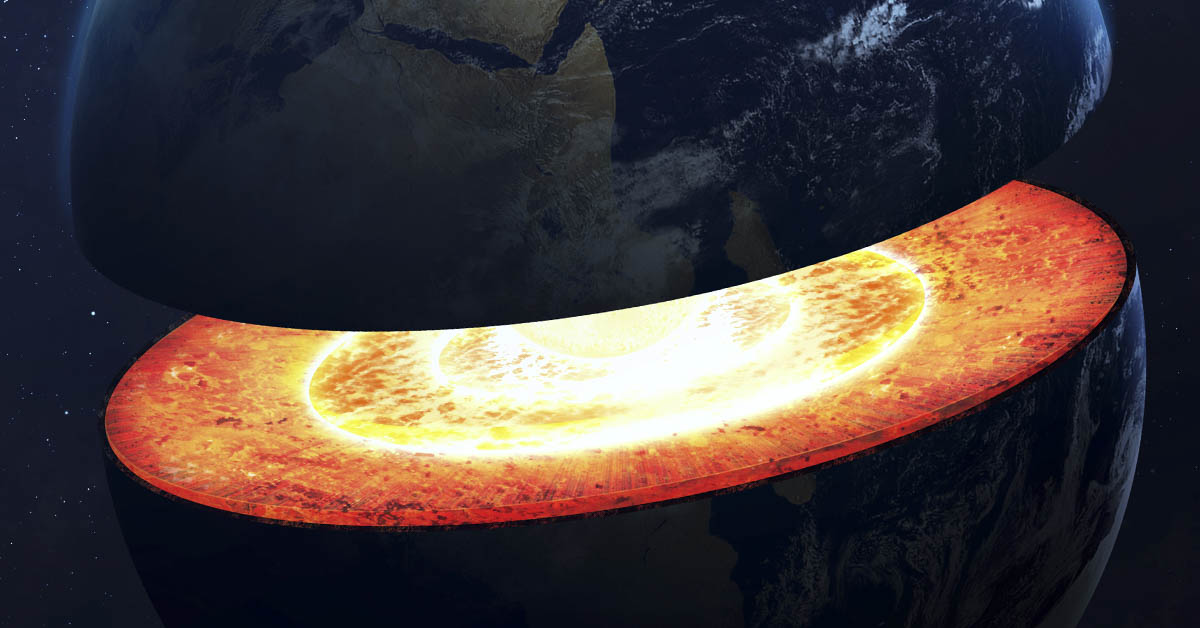The depths of the Earth, still largely unexplored, harbour tantalizing mysteries. A team of scientists recently presented evidence that two gigantic structures deep within our planet could be the remains of an ancient planet.1
Tracing Echoes of an Ancient Planet
Large Low Shear Velocity Provinces (LLSVPs) are vast structures that baffle researchers due to their incredible size and puzzling properties. Existing near Earth’s core-mantle boundary, one structure resides beneath Africa, the other under the Pacific Ocean. Scientists have long debated their density and composition.2
Intriguingly, a recent analysis of seismic data is offering new insights. The two structures might be remnants of an ancient planet that collided with the Earth during its formative years, leaving its indelible mark etched into the fabric of our world.3
The hypothesis hinges on understanding the chaotic infancy of our solar system. During Earth’s formation period, our planet was a dynamic and evolving entity. It encountered numerous other bodies, often colliding and merging with them. Each of these violent events contributed to Earth’s growth. In fact, one such proposed collision with a Mars-sized ancient planet named Theia is thought to have led to the creation of our Moon.
Evidence From the Depths
The seismic evidence associated with LLSVPs has revealed surprising details. These structures are denser and compositionally different from the surrounding mantle. The sheer size of these structures suggests they could only have formed during a significant planetary collision. The colossal impact would cause the iron-rich core of the ancient planet to sink towards Earth’s center, while less dense material would scatter and mix into the mantle. These findings align with observations of the LLSVPs, supporting the hypothesis of their extra-terrestrial origin.
Read: Earth’s Spinning Inner Core Recently Paused Then Flipped Its Direction
Implications and Future Directions
Should the LLSVPs indeed represent remnants of an ancient planet, they raise thought-provoking questions about Earth’s geodynamic evolution. This could imply that the Earth’s mantle has remained unmixed over billions of years, preserving these gigantic structures.
Moreover, the discovery provides valuable insights into our planet’s interior dynamics. These structures might influence mantle convection, plate tectonics, and volcanic activity. They could also play a significant role in the geochemical evolution of Earth’s surface and potentially even influence the geomagnetic field.
If these structures are remnants of an ancient planet, it would offer substantial evidence to theories of planetary formation and evolution. It might corroborate the hypothesis that terrestrial planets, including Earth, expanded by merging with other planetary bodies during their formative years.
Earth’s Past and The Road Ahead
Though the evidence appears compelling, it is essential to approach these findings with cautious optimism. While the data seem to support the “ancient planet” hypothesis, alternative explanations need to be explored further. Additionally, more data is needed to understand the precise nature of the LLSVPs, including their composition, density, and role in Earth’s geodynamics.
The possibility of an ancient planet buried deep within Earth serves as a poignant reminder of the planet’s violent and complex past. As we continue to explore the uncharted territories within our own planet, we may discover more echoes of what lies beneath us, each one a chapter in Earth’s formative history. These deep-earth relics tell a story of a time when our planet was a young, dynamic entity, charting its course through the chaos of the early solar system.
With the evolution of technology and research methodologies, we are bound to uncover more secrets that our Earth has carefully preserved over the eons. As we continue to delve into the deep unknowns of our planet, we might find more relics of ancient planets, each contributing another piece to the grand puzzle of Earth’s formation and evolution. Amidst all the challenges and breakthroughs, one thing is for sure: Our Earth ceaselessly surprises us, revealing its secrets one layer at a time.
Keep Reading: Earth’s Core May Be Causing Strange ‘Anomalies,’ Study Suggests
Sources
- “Subducted oceanic crust as the origin of seismically slow lower-mantle structures.” Progress in Earth and Planetary Science. Timothy D. Jones, et al. May 21, 2020.
- “Formation of large low shear velocity provinces through the decomposition of oxidized mantle.” Nature. Wenzhong Wang, et al. March 26, 2021.
- “Why Scientists Think There May Be Parts Of An Ancient Planet Inside Earth.” Huffington Post. Kate Nicholson. June 12, 2023.

